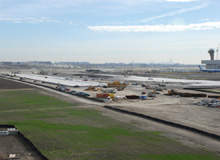
As the second-busiest airport in the world, O’Hare International Airport’s stature in the global aviation sector speaks for itself. In 2008, the Chicago airport handled 69,353,654 passengers and was home to 881,566 aircraft operations, while it is also the largest hub of United Airlines and the third-largest hub of American Airlines
Yet, the airport’s popularity also proved its downfall, as high volumes and crowded schedules increasingly led to lengthy delays and cancellations. Some sources even began to rank O’Hare as one of the least punctual airports in the US. Realising this, the O’Hare modernisation programme (OMP) was unveiled in June 2001 by Chicago Mayor Richard Daley in a bid to transform the airport’s outdated infrastructure.
Much of O’Hare’s existing problem is due to the fact that the airport was originally built in the 1950s as a military manufacturing facility for Douglas aircraft. Due to the wind-sensitive propeller-driven planes of that time, an intersecting runway system, featuring three runways that form a triangle, was implemented. With the last of the three runways constructed over 37 years ago, the original configuration is in desperate need of renovation.
In the long run
The approximately $8.7bn modernisation programme features a total of eight runways – six of which will run parallel in an east-west direction and two of which will run diagonally. The longest of the runways will span 13,000ft and the shortest one 7,500ft.
The new parallel configuration revolves around the relocation of the three existing runways, one new runway and the extension of two existing runways.
How well do you really know your competitors?
Access the most comprehensive Company Profiles on the market, powered by GlobalData. Save hours of research. Gain competitive edge.

Thank you!
Your download email will arrive shortly
Not ready to buy yet? Download a free sample
We are confident about the unique quality of our Company Profiles. However, we want you to make the most beneficial decision for your business, so we offer a free sample that you can download by submitting the below form
By GlobalDataThe extension of existing runway 10/28 opened 56 days ahead of schedule and $33m under budget on 25 September 2008, while the concrete paving work for runway 10C/28C is due to begin in 2009.
The creation of an entirely new airstrip – runway 9L/27R – was commissioned along with a new air traffic control tower in November 2008. According to OMP’s executive director Rosemarie Andolino, all these activities led to last year proving particularly successful for the programme.
“During 2008 we commissioned two runway projects and the air traffic control tower. All this work was completed on time or even ahead of schedule. While we are certainly proud of what we have done so far, there is much more work left to do,” Andolino says. “2009 will be another important year for our programme as we move forward with our remaining design structure projects.”
The ambitious scale of the project means the OMP can ill-afford to rest on its laurels. The new runway, for instance, will be 7,500ft long by 150ft wide and has group 5 CAT II/III capability, designed for planes as large as the Boeing 747. It will also have a state-of-the-art instrument landing system and embedded weather sensors in the pavement that will alert the air control traffic tower of ice on the runway.
June 2001.”
A report from the Federal Aviation Administration (FAA) found that the new runway could also reduce delays from an average of 24 minutes to 16 minutes a flight. It could also offer an additional 52,000 flights annually.
Once the entire parallel runway configuration is complete, not only will delays be reduced and capacity increased, but costs will be lessened for airlines operating at O’Hare through reduced delay and fuel burn.
“Furthermore, OMP will create 195,000 jobs for the region on top of the 450,000 jobs already at the airport. It will also add $18bn each year to the $38bn O’Hare generates for our region today,” Andolino says.
More distant plans for the OMP project include a new terminal on the west-side of the airport, which will host up to 60 gates. The new terminal will also help improve transportation access to the site.
“Today, all vehicles entering O’Hare must use a single entrance point on the eastern side of the airport. Taking existing and future road plans into consideration, the new western terminal will be positioned so that an area expressway can come directly into the airport,” Andolino says.
Sustaining a lead
Stringent environmental and sustainable initiatives have played a prominent role throughout the development of the OMP. A sustainable design manual was completed in December 2003 that was distributed to all designers involved in the project and included in all subsequent contracts.
This unique approach has driven forward a number of developments, such as the first green roof to be installed at a FAA air traffic control tower and the recycling of more then 100,000t of metal, wood, brick, corrugated cardboard, asphalt and concrete for construction purposes on the site. The OMP also plans to replace 154 acres of low-quality, inaccessible wetlands on airport property with nearly 450 acres of higher-quality wetlands. The scheme will cost no more than $44m and will provide a more natural environment for birds and wildlife while increasing passive recreation space for neighbouring communities.
Such a sustainable and environmentally conscious attitude has meant the modernisation programme has already won its fair share of plaudits and if planning and construction continue to run on schedule, it won’t be long until O’Hare International Airport itself will be stealing the accolades.







